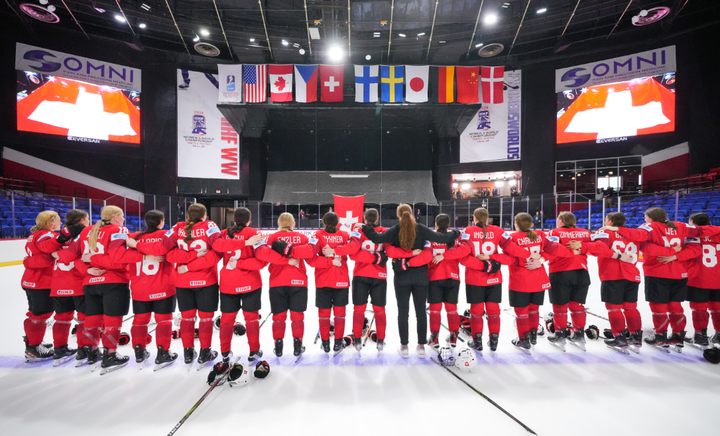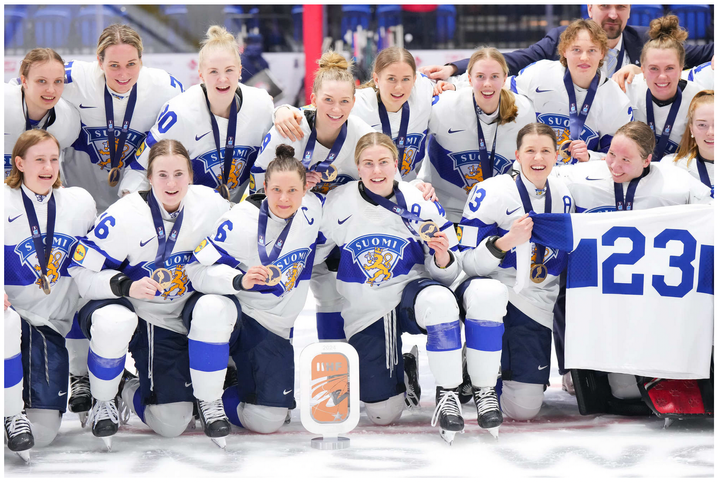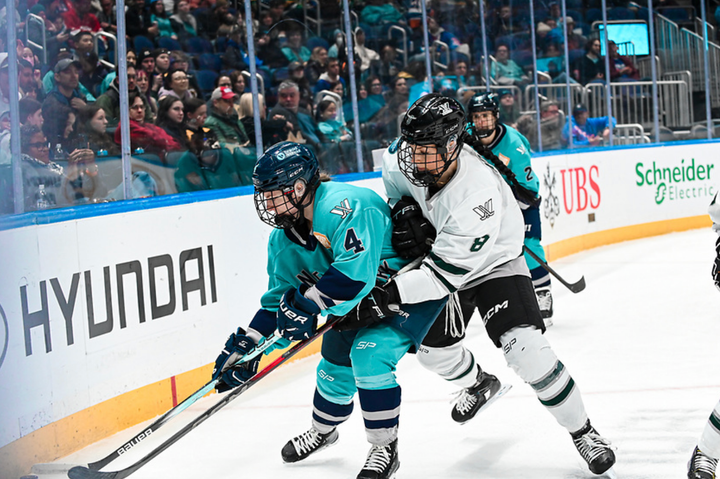Kaleigh Fratkin on the #ForTheGame movement, the PWHPA, and her decision to return to the NWHL
The returning NWHL veteran shares her side of the story
On May 20, Kaleigh Fratkin became the first player to sign with an NWHL team for the 2019-20 season. Over the last few days she’s been followed by four others, including fellow NWHL veterans Madison Packer and Shannon Doyle.
There are, however, no guarantees that we will see a fifth season of NWHL hockey. The league’s next season is currently in jeopardy because over 200 players have pledged not to play professional hockey in North America next season. That group includes the majority of the game’s most popular and influential stars. On May 2, they all took to social media and made their pledge known to the world in what has become known as the #ForTheGame movement.
Recently, that same group of players filed for incorporation under the banner of the freshly-forged Professional Women’s Hockey Players’ Association.
Related
Professional Women’s Hockey Player Association established, issues statement
Fratkin was one of the first players that emerged as a dissenting voice. She issued a statement that was first reported by Marisa Ingemi of the Boston Herald on the day that #ForTheGame swept through Hockey Twitter.
“I believe in fighting for equal rights and what we deserve as women hockey players. But with that being said in the current state of women’s hockey, I truly think by deciding not to play, and folding the only league that’s left for the sport is the wrong thing to do. We should all be on board and come together into the last league standing, the NWHL, and showcase for the first time ever the best women’s hockey in one league.”
Fratkin, 27, is no stranger to professional women’s hockey. She has played with and against many of the best players in the world and is counted among them. Next season will be Fratkin’s sixth as a pro. She spent a year in the CWHL with the Boston Blades before signing with the NWHL’s Connecticut Whale in 2015. After a year with the Riveters, the Boston University alumna signed with the Pride in 2017. She’s been in black and gold since.
Related
Kaleigh Fratkin re-signs with Boston Pride for 2019-2020 NWHL season
Two days after inking her fifth NWHL contract, Fratkin talked with The Ice Garden about her decision to sign, the #ForTheGame movement, the PWHPA, and the current state of professional women’s hockey.
Note: sections of this interview have been edited for brevity and clarity.
The Ice Garden: You were the first player to sign a contract for the upcoming NWHL season. Was there ever any doubt for you re-signing with the Pride, especially with the #ForTheGame movement going on?
Kaleigh Fratkin: It was definitely something that I had to put some thought into, obviously. I wouldn’t say that there were doubts. I think a lot of the background noise made it into a [decision] that wasn’t as easy as it had been in the past.
Being in the league for so long, I’ve always been so pumped getting into the offseason and thinking about coming back for another season. I’d say that this year has been more challenging and more thought-provoking than it [has been] over the past four years.
After considering a lot of what has been going on I made that decision; that I wanted to support the league. I wanted to be vocal about how important I think it is to play in the NWHL this year.
TIG: Have you been in contact with the newly-formed Professional Women’s Hockey Players’ Association since signing or before you signed?
KF: Yeah, so now I am not.
With signing, it was kind of — at the beginning, when I was approached about if I was going to join the movement or not and [asked] about my stance I had a ton of questions. I asked for follow-up, I asked when I would be getting those answers, and I never got them. I know that the [PHWPA] has had multiple phone calls and none of them have been directly sent to me. That’s because I chose not to be a part of the movement, so they didn’t include me in any of it. But I know a lot of people that have been getting that information. They have been passing it along to me. So, indirectly, I have been hearing what’s been going on.
I’ve been focused on what I can do to help make players more aware of the other side of it. Also, at least from where I stand, how important I think it is to be playing [this year]. That’s really my focus.
When I was approached about if I was going to join the movement or not and [asked] about my stance I had a ton of questions. I asked for follow-up, I asked when I would be getting those answers, and I never got them.
TIG: When I first heard about #ForTheGame, it seemed like it was maybe risking a lot in terms of how much momentum we’ve seen the NWHL build over the last few years. That may just be my take from the outside looking in, but is there a clear lack of direction? Is that an issue for you, even if you agree with what the PWHPA ultimately seeking?
KF: Yeah. I decided to leave the CWHL and have stayed in the NWHL for as long as I have for the growth of the sport. You know, in women’s hockey, we all want the same end game. We all want the same thing; we all want the sport to be successful and we want all want future generations to be able to do this as a full-time job.
I think what’s been really difficult for myself, and I can only speak for myself, is that when someone approached me with an idea that’s silver and shiny and says, ‘Hey, the NHL is going to start a league in 2020.’ I had some skepticism. I had some questions.
I want to know if we’re ultimately doing this for the salary, better resources, and to make it more sustainable, what does that look like? You know, do we have a [plan] that’s already solidified? If there was something legitimate there, if there was some sort of contractual agreement that said, ‘Hey, this is the money that you’re going to be making, these are where the teams will be, this is what it’s going to look like,’ then I would be looking at it a little bit differently.
What will that look like? I’ve been trying to look at all of this by taking a step back. The end game is the same for everyone, but is this really our best road? I think that this isn’t the best way to leverage what we’ve been building, and that’s been really difficult for me.
When none of those questions can be answered, and you don’t even know what the pay is going to look like, it just seems kind of silly. Like you just said, [the NWHL] has been building up momentum. I’ve seen it. I’ve been a part of it since day one. It was a startup, I saw the struggles, the ups and downs, and the salaries getting cut. Anyone that works in the business world sees those things. I see it on a daily basis, and I work for multi-billion dollar company.
It’s been a struggle for me to completely turn away from the positives that we’ve seen in the NWHL over the past couple of years — to see that tremendous growth in a really short period of time. It’s been hard for me to say that the best option here is to completely kibosh [the league] that’s left and to turn around say we need someone else to restart it.
What is that going to look like? Is that going to cut the women’s hockey workforce by over 75 percent? What will that look like? I’ve been trying to look at all of this by taking a step back. The end game is the same for everyone, but is this really our best road? I think that this isn’t the best way to leverage what we’ve been building, and that’s been really difficult for me.
TIG: Without naming any names, do you know of other players who have raised questions that also weren’t answered? Are there a lot of them? Also, do you think some of the lapses in communication you experienced were a result of how large this group of athletes is?
KF: Not to name players, but I would need more than two hands to count the number of players that I have been talking to that have asked the same questions. Anyone who looks at this situation will start asking questions. I know people who aren’t even close to the game who have been asking similar questions.
It comes down to a situation where — and it’s kind of sad to say it — there are players who almost feel like if they’re not going along with it, then it will look like they don’t want what’s best for the sport.
When I was first approached with it I had my questions, I finished the conversation, and then thought about it for about 24 hours before I was asked, ‘Are you with us, or not?’
Well, wait a second. Am I going to be the only person who is not on board? I had those questions too. I think it’s normal to. I can only imagine how I’d feel if I was a girl just coming out of college who is five or six years younger than I am now. Imagine idolizing a lot of the players who are making these decisions and who are asking these young girls if they are on board. If I was in their shoes, I wouldn’t know what to do. How could you?
I think in this situation there’s a lot of assumption that the players [in leadership] are consulting with the right people and are doing their due diligence. It’s kind of a leap of faith for those people. I personally don’t think that is the best thing, but there are some people who are doing it because they don’t know what else to do. That’s a problem. I think there’s been a lack of guidance and information. As opposed to doing this as a massive group, it’s been more of a ‘are you with us or not’ situation. And if you’re not with it, we’re going to do our own thing instead of addressing the divide.
It comes down to a situation where — and it’s kind of sad to say it — there are players who almost feel like if they’re not going along with it, then it will look like they don’t want what’s best for the sport.
What I’m really confused and skeptical about is why there has never been a group representing the movement that has come forward to the NWHLPA that is willing to do business. We’ve never seen a group saying, ‘Let’s negotiate about what we want and try to do business together.’ They have just chosen to do business elsewhere, for whatever reason. So, that’s where I wonder if they’re in this for the best interest of the sport, or if there are personal gains in this, or are you trying to do this in the quickest way possible without considering what the ripple effect of a year without hockey would do to the sport.
TIG: Do you have reservations about giving the keys over to the NHL to create a WNHL? It seems like a lot of the questions that you raised are related to that. Is that why some of this maybe feels rushed, or do you think there is more structure to their plan?
KF: The way that I’m seeing it is they had their movement and then their next steps were creating their website and filing for articles of incorporation. From there, they [will be] looking for sponsors [and] for people to invest in them, with the NHL being the prime investor.
If you look at women’s pro soccer or the WNBA, their male counterparts on the professional side are involved. Of course you want to activate the NHL. But is completely forcing their hand by destroying the NWHL the right way to do this?
In my opinion, we should be leveraging the league that we have and [approaching] the sponsors that support our male counterparts and then turning to the NHL to say, ‘Hey, these sponsors are now supporting us because they want to get behind the women’s movement.’ That way we can activate the NHL. Rather than kyboshing the NWHL and have the NHL start things from the ground up.
You have to look at it realistically. If you start a league from the ground up, what are we talking about here? Four or five teams? There are not enough spots for all of the players in the #ForTheGame movement on those teams. I think that, in the long run, that is not the best way to go.
Of course you want to activate the NHL. But is completely forcing their hand by destroying the NWHL the right way to do this?
We all went to college and we all have degrees. One hypothetical that’s been talked about is making $40,000 a year to have hockey as a 9-5 job, but only playing against four teams. That would push back my own career by a number of years. If you look at it in the long term, it is a step backwards. With the setup in the NWHL, with the new 50-50 revenue split, we could all be making good money doing this as a part-time job where you practice twice a week and play games on the weekend. You’re still growing the game and the entertainment value of the sport will keep going up.
I think there would be a lot of positives if everyone can play in the league this year. Players, on average, could be making an average of $7,000 — or whatever it is — and the money we’d get on top of that. That’s why we should put a lot of effort into leveraging for sponsors. Then you are making similar money to what you’re asking for when you’re considering how much you’ll make from [the NWHL] as a part-time job on top of what you’re already making in your professional career.
It’s a frustrating situation. I think a lot of people are just ill-informed on the long-term effects of what we are really doing here.
TIG: We’ve seen four players sign with the NWHL in just the last couple of days. Do you feel confident that enough players will sign to fill the NWHL’s rosters, whether that’s five teams or seven teams? Are there enough players outside of the #ForTheGame movement to make it happen?
KF: I really hope so. I think there’s a lot of players coming out of college that will help. I think there’s also players who are currently on board with the movement — but who’s to say that they can’t change their mind? They aren’t signing a contract saying that they aren’t playing, they are posting on social media.
I don’t think it’s far-fetched at all. I know for a fact that there are a lot of conversations going on with the GMs and the coaches. Specifically, for the Boston Pride, I know that there’s a lot of due diligence being done to get players to come play.
Quite honestly, the league has gone on with and without a lot of those big names and the quality of hockey has always been there.
If we were in this situation two years ago — which really isn’t that long ago, but that’s a long time in NWHL-world — I would probably say no. We’d be really scraping the barrel and I don’t think that we’d be able to field teams. Today, with what has been established in the past couple of years, I think it’s pretty realistic. The depth of women’s hockey is great, and I think the last two years are prime examples of that.
A lot of the players in the movement haven’t played in the NWHL for a while. Some of them left halfway through the second year when salaries were cut, or they barely played in games and just showed up when they wanted to. Quite honestly, the league has gone on with and without a lot of those big names and the quality of hockey has always been there.
Obviously, it definitely helps to have the best hockey players in the world playing together in one league, but there are a lot of players out there that are really good. That depth has really been showcased over the last few years. I think that’s a testament to where the sport is and how many talented girls we have coming out of college.
In a way, that also shows what the NWHL has done. Girls who are coming out of college want to come play in the league now. Tori Sullivan and other [rookies] have seen this league grow and they want to play in it.





Comments ()